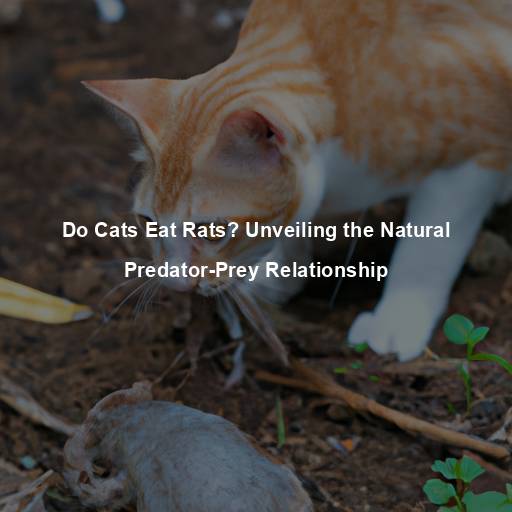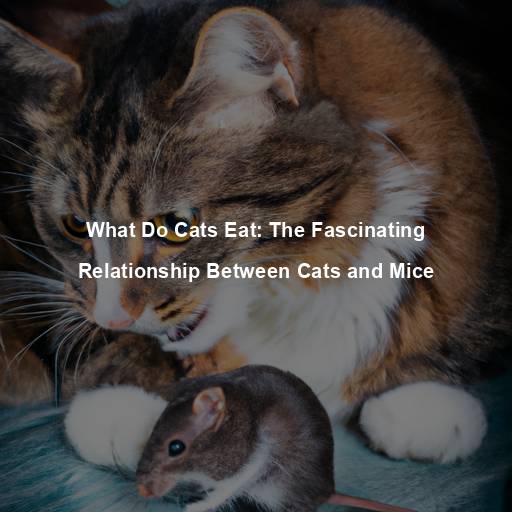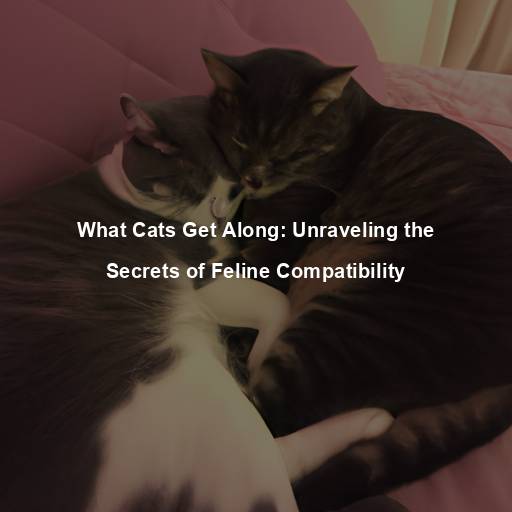Do Cats Eat Rats? Unveiling the Natural Predator-Prey Relationship
Last Updated on October 25, 2023 by Evan
Contents
- 1 The Fascinating World of Cats and Their Hunting Instincts
- 1.1 The Instinctual Drive: Unleashing the Hunter Within
- 1.2 A Game of Cat and Mouse: Understanding the Predator-Prey Relationship
- 1.3 Domestic Cats vs. Rat Infestations: A Battle of Wits and Survival
- 1.4 Pet Cats and the Rat Conundrum: What Should Owners Expect?
- 1.5 The Ethics of Cat-Rat Interactions: Finding a Balanced Perspective
- 1.6 Debunking the Stereotype: Cats as Ultimate Rat Catchers
- 1.7 The Complex Ecological Balance: A Multifaceted Perspective
- 1.8 The Role of Cats in Pest Control: A Collaborative Effort
- 1.9 Responsible Pet Ownership: Ensuring the Welfare of Cats and Wildlife
- 1.10 The Intricate Web of Nature: An Ever-Evolving Relationship
- 2 FAQs – Do Cats Eat Rats
- 2.1 Can cats eat rats?
- 2.2 Is it safe for cats to eat rats?
- 2.3 Do cats only eat rats when they are hungry?
- 2.4 Are all cats good at hunting rats?
- 2.5 What are the benefits of letting cats eat rats?
- 2.6 Should I be concerned if my cat eats a rat?
- 2.7 How can I prevent my cat from eating rats?
- 2.8 What are some alternative ways to control rat populations?
The Fascinating World of Cats and Their Hunting Instincts
For centuries, the enigmatic and graceful cats have bewitched humans with their perplexing behavior and unmatched hunting prowess. Among the many mysteries surrounding them, one question looms larger than others: do these creatures actually dine on rats? It’s a topic that sparks curiosity and leaves us pondering the intricate predator-prey dynamics between cats and rats. In this captivating read, we will navigate through the labyrinthine world of feline hunting instincts, uncover the motives behind their behavior, and shed light on what it means for those who share their homes with these captivating hunters.
The Instinctual Drive: Unleashing the Hunter Within
From the moment kittens open their eyes, they begin to exhibit their hunting prowess, playfully pouncing on toys or even their littermates. This behavior stems from their innate survival instinct, deeply ingrained in their DNA. Cats are natural predators, descendants of their wild ancestors who relied on hunting for survival. Their bodies are perfectly designed for stalking and capturing prey, with sharp retractable claws, keen eyesight, and superior agility.
A Game of Cat and Mouse: Understanding the Predator-Prey Relationship
The Hunt Begins:
When it comes to rats, cats perceive them as worthy adversaries. Rats, known for their intelligence and agility, provide an enticing challenge for cats looking to satisfy their hunting instincts. The chase begins as soon as a cat senses the presence of a rat, triggering their predatory mode.
The Art of Stalking:
Cats are masters of stealth, employing their keen senses to cautiously stalk their prey. They rely on their acute hearing and exceptional night vision to silently maneuver, patiently waiting for the perfect moment to strike. Their ability to remain still for long periods, coupled with their unwavering focus, ensures a successful ambush.
The Capture:
Once the moment arrives, cats unleash their lightning-fast reflexes, launching themselves towards the rat with precision and agility. Their sharp claws and powerful jaws enable them to quickly immobilize their prey, ensuring a swift and effective capture.
The Feast:
Once the wild instincts take over and the feline conquers its prey, a moment of pondering ensues. Cats, being the discerning carnivores that they are, face a enigmatic conundrum: to rat or not to rat? There is no definitive answer, as their self-indulgence knows no bounds. Some cats might decadently savor the spoils of their victory, while others embark upon a grand display of their palpable power by presenting the rat to their human comrades, a trophy of sorts.
Domestic Cats vs. Rat Infestations: A Battle of Wits and Survival
The Rat Menace:
It’s no secret that rats, those mischievous troublemakers, have a knack for wreaking havoc wherever they go. From bustling city streets to tranquil countryside retreats, no place is safe from their relentless conquest. With their rapid breeding habits and penchant for destruction, it’s no wonder these furry fiends send shivers down the spines of property owners everywhere. But fear not, dear readers, for we have embarked on an epic quest to unveil the most ingenious, efficient, and compassionate means of curbing the rat population.
The Cats’ Role:
Enter the domestic cat, a potential ally in the battle against rat infestations. In many cases, cats have been employed as natural pest control agents, utilizing their hunting skills to keep rat populations in check. Their mere presence acts as a deterrent, as rats are instinctively aware of the feline presence and will avoid areas where cats reside.
The Pros and Cons:
When it comes to tackling those pesky rat problems, cats can definitely bring some feline finesse to the table. However, let’s not jump the gun and assume they’re the ultimate solution. While cats can put a dent in the rat population, they might not whisk them away entirely. Plus, let’s not forget the potential risks our furry friends face, like getting hurt or picking up some unwanted diseases from their rodent encounters.
Pet Cats and the Rat Conundrum: What Should Owners Expect?
The Indoor Dilemma:
Keeping indoor cats can greatly reduce the chances of cat owners crossing paths with rats. However, it is not entirely uncommon for these sneaky rodents to venture into homes through tiny crevices. When this happens, feline friends may tap into their natural hunting instincts and set out to capture or even devour these unexpected guests. To safeguard our beloved companions, it is imperative that owners promptly tackle any rat-related concerns and establish a secure haven for their cats.
Outdoor Adventures:
Did you know that our feline friends who love to roam outdoors may come face to face with some uninvited guests? Yes, I’m talking about the notorious rats! These mischievous critters can pose a serious threat to our beloved cats, transmitting diseases through bites or scratches. But fear not!
Prey vs. Play:
When it comes to our feline friends, there’s more than meets the eye. While it’s intriguing to think that cats devour every rat in sight, the truth is, they have their own fascinating ways. Some cats, rather than satisfying their taste buds, engage in a playful game of chase, showcasing their innate predatory instincts. It’s a curious phenomenon that speaks volumes about their nature, reminding us that there’s more to their behavior than meets the eye.
The Ethics of Cat-Rat Interactions: Finding a Balanced Perspective
Respecting Natural Instincts:
Cats are hardwired to hunt and exhibit predatory behavior. As pet owners, it is crucial to respect and understand this natural instinct. Discouraging or punishing cats for displaying their hunting behavior may lead to stress and behavioral issues. Instead, providing alternative outlets for their predatory instincts, such as interactive toys or puzzle feeders, can help redirect their energy in a more appropriate manner.
Promoting Coexistence:
Rats, often associated with nuisance, surprisingly hold significant importance in the intricate balance of ecosystems. With this in mind, it becomes imperative to explore alternative approaches to pest control, taking into account the welfare of all creatures involved. Strategies such as efficient waste management, expertly sealing entry points, and the utilization of humane traps can effectively address rat-related concerns, ensuring the coexistence of cats and various other animals without compromise.
Debunking the Stereotype: Cats as Ultimate Rat Catchers
When it comes to the legendary rivalry between cats and rats, misconceptions often blur the lines of truth. While cats do possess formidable hunting skills, their role in eradicating rat infestations might not be as straightforward as we think. Let’s delve into the captivating realm of feline and rodent dynamics to unravel the complex reality behind these age-old adversaries.
The Reality Check:
In the mysterious realm of the animal kingdom, a captivating phenomenon known as “Selective Prey Preference” has researchers bewildered. With a curious mix of fascination and perplexity, scientists strive to unlock the secrets behind the intriguing choice of prey exhibited by certain predatory creatures. This enigmatic behavior, characterized by a specific predilection for certain prey species, sparks a tailored approach to hunting that has perplexed experts and ignited a fiery desire to comprehend the intricate patterns woven within the vast tapestry of nature’s delicate balance. As the enigma deepens, the quest to unravel the complexities of this selective prey preference takes us on a thrilling journey into the captivating inner workings of the animal world.
Cats display a discerning taste when it comes to their hunting preferences, opting for a diverse smorgasbord of potential victims instead of exclusively fixating on rats. Driven by their innate instincts, these cunning felines often set their sights on smaller, more easily conquerable creatures like mice, birds, and even insects. The formidable nature of rats can sometimes deter these fickle hunters, causing them to explore alternative options in their quest for elusive prey.
Despite initial expectations, recent studies have revealed that the implementation of various measures targeting rat populations has yielded limited results. This surprising finding has left experts and researchers perplexed, as the traditional methods have historically shown promising outcomes. The burst of confusion surrounding this issue has sparked debates among pest control professionals, as they strive to understand the factors contributing to the unexpected lack of success. As a result, the search for more effective strategies to combat the rat problem continues, injecting a sense of urgency and uncertainty into the field.
While cats can play a role in reducing local rat populations, their impact may be limited. Rats are highly adaptable creatures, capable of reproducing rapidly and evading predators. Even the most skilled feline hunter cannot completely eradicate a well-established rat infestation.
The Complex Ecological Balance: A Multifaceted Perspective
Understanding the complex relationship between cats, rats, and their environment requires a multifaceted perspective that considers various factors at play.
The Cat’s Hunting Success:
The success rate of a cat’s hunting endeavors largely depends on factors such as the cat’s skill, experience, and the availability of prey. Cats living in urban areas may have limited access to rats due to well-managed waste systems, reduced rat populations, or the presence of alternative food sources.
Rat Behavior and Adaptability:
Rats, those cunning and versatile creatures, possess a remarkable knack for adjusting their strategies in order to evade those who wish them harm. With a keen sense of their surroundings, they deftly navigate the treacherous landscape, avoiding the ever-watchful gaze of feline foes and other perils. These crafty rodents seek shelter in the most obscure recesses and alter their dining habits at will, making it an enigma for cats to establish unwavering dominion over the rat populace. One can only marvel at the bewildering ways in which these resourceful beings outsmart their predators, leaving even the most astute observers in a state of perpetual perplexity.
Human Intervention and Environmental Factors:
When it comes to using cats as rat deterrents, there are various factors at play that may impact their effectiveness. It’s not just about the feline’s innate abilities, but how humans intervene and work with the environment. By implementing proper waste management practices, sealing entry points, and ensuring a clean environment, the allure for rats can be greatly diminished, thus decreasing the likelihood of an invasion.
The Role of Cats in Pest Control: A Collaborative Effort
The idea of cats being the ultimate rat exterminators may seem a bit exaggerated, but that doesn’t mean they can’t lend a paw in pest control. When it comes to tackling pesky rodents, a collaborative approach can go a long way in harnessing their potential. While their contributions may not be earth-shattering, it’s worth considering their role alongside other methods in our battle against these scurrying nuisances. So, let’s embrace the idea of working together in our ongoing quest for a pest-free environment.
Natural Deterrents:
The presence of cats can act as a natural deterrent for rats. Rats are instinctively aware of the feline presence and tend to avoid areas where cats reside. This can help prevent rat infestations from occurring in the first place, as rats seek alternative locations.
Supplementary Pest Control:
Cats can serve as a supplementary tool in integrated pest control strategies. When combined with other preventive measures such as proper sanitation, sealing entry points, and humane traps, cats can help keep rat populations in check, reducing the need for more invasive methods.
Companion and Pest Controller:
It is important to remember that cats are primarily companions and pets, providing love, companionship, and joy to their human caretakers. While they may assist in controlling rat populations, their well-being and happiness should remain a priority.
Responsible Pet Ownership: Ensuring the Welfare of Cats and Wildlife
As responsible pet owners, it is our responsibility to prioritize the welfare of our feline companions while also considering the impact they may have on local wildlife.
Indoor Enrichment:
As feline enthusiasts, we all know the importance of creating a captivating indoor environment for our beloved cats. It’s not just about keeping them entertained, but also addressing their innate hunting instincts. With a thoughtful selection of interactive toys, scratching posts, and ample vertical spaces, we can effortlessly replicate the thrill of the chase, offering our feline friends both mental and physical stimulation. It’s time to embark on a journey of discovery and wonder, as we delve into the perplexing world of feline enrichment.
Supervised Outdoor Time:
Ensuring the safety and well-being of your outdoor cat requires vigilant supervision and careful consideration. It is vital to regularly assess their surroundings, create secure enclosures, and closely monitor their interactions with the wildlife around them. By taking these proactive measures, you not only protect your furry friend but also preserve the harmony and balance of the local ecosystem.
Collar and Identification:
It’s a cat-astrophe waiting to happen if our feline friends venture too far from home without proper identification. To ensure their safety and whisker-riffic reunions with worried owners, outdoor kitties should don fashionable collars adorned with identification tags or be microchipped. By embracing these purr-rect precautions, we can minimize the chances of our adventurous felines becoming perplexed wanderers in the vast wilderness beyond their cozy abodes.
The Intricate Web of Nature: An Ever-Evolving Relationship
The relationship between cats and rats is a complex interplay of natural instincts, environmental factors, and human intervention. While cats possess remarkable hunting abilities, they are not infallible rat exterminators. Instead, their role in pest control should be viewed as part of a collaborative effort that includes preventive measures, responsible pet ownership, and a broader understanding of the intricate web of nature. By acknowledging the limitations and embracing a balanced perspective, we can promote the well-being of our feline companions while respecting the ecological balance of our shared environment.
FAQs – Do Cats Eat Rats
Can cats eat rats?
Cats, oh how fascinating they are! These mesmerizing creatures boast an inherent prowess for the hunt, truly ingrained within their very being. With their sharp teeth that can cut through the air like a masterful sword and claws that can seize their prey with astonishing precision, cats effortlessly embark on a thrilling mission to subdue even the most elusive of rats. It’s truly captivating to witness this display of their primal instinct, a magnificent spectacle that reaffirms their unwavering position as skillful predators of the animal kingdom.
Is it safe for cats to eat rats?
Feasting upon rats may seem like second nature to our feline friends, yet it comes with a twist of uncertainty. Behind those beady-eyed rodents lies a trove of risks, as they might harbor a host of diseases, parasites, or harmful pathogens that could pose a threat to our beloved cats. Caution becomes paramount, as we must carefully assess the rat’s health and ascertain it has not fallen prey to poisoning before granting our furry companions this unconventional feast to safeguard their overall well-being.
Do cats only eat rats when they are hungry?
Not necessarily. Cats are driven by their hunting instinct, which goes beyond satisfying their hunger. Even well-fed cats may choose to chase, catch, and eat rats if given the opportunity. Hunting behaviors provide mental and physical stimulation for cats, and this instinct is deeply ingrained in their nature.
Are all cats good at hunting rats?
When it comes to the timeless art of rat hunting, feline prowess varies like strokes on a painter’s canvas. Not every cat possesses the same lethal finesse in snagging those elusive rodents. Certain breeds exhibit an innate predatory instinct, honed through generations, that propels them to unparalleled heights of rodent dominion. However, there exists a cornucopia of factors, as diverse and perplexing as the meanderings of a cat’s ever-curious mind, which can tip the scales towards triumph or tribulation in the perilous rat-catching quest. Ebbing and flowing in the enigmatic tapestry of each individual cat’s personality, curiosity, and insatiable appetite for adventure dance hand in paw with their success as rat conquerors, unraveling the complex web that is the feline-rat relationship.
What are the benefits of letting cats eat rats?
Allowing cats to hunt and eat rats can help fulfill their natural instincts and provide mental stimulation. It can also be seen as a way of pest control, especially in areas where rats are a problem. However, it is crucial to monitor your cat’s behavior and ensure their safety and health while engaging in rat hunting activities.
Should I be concerned if my cat eats a rat?
Witnessing your furry feline pounce on a rat and devour it may leave you questioning the situation. Fear not, for our feline friends possess exceptional digestive prowess, perfectly primed for consuming uncooked prey. Yet, it remains imperative to stay vigilant, closely observing any peculiar signs of sickness or behavioral alterations that may emerge in the aftermath. Should your cat exhibit any disconcerting symptoms, seeking professional guidance from a veterinarian is undoubtedly the wisest course of action.
How can I prevent my cat from eating rats?
Preventing your cat from eating rats may be challenging, as it goes against their natural instincts. However, you can limit your cat’s exposure to rats by keeping them indoors or creating an enclosed outdoor area. Additionally, providing your cat with appropriate toys and engaging in interactive play can help satisfy their hunting instincts without relying solely on catching rodents.
What are some alternative ways to control rat populations?
If you are concerned about rat infestations but prefer not to rely on your cat as the primary method of control, there are alternative approaches. These include implementing proper sanitation practices, sealing any entry points, using rat traps, or seeking professional pest control services. It is crucial to choose methods that are safe and effective for both your pets and the environment.







